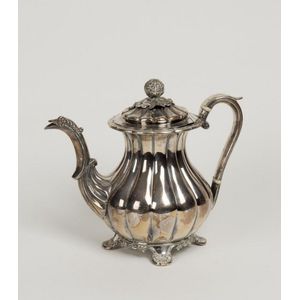French Silver Teapot and Milk Jug, Late 19th Century
You must be a subscriber, and be logged in to view price and dealer details.
Subscribe Now to view actual auction price for this item
When you subscribe, you have the option of setting the currency in which to display prices to $Au, $US, $NZ or Stg.
- Foliate - Decorated with leaves or leaf-like forms.
- Hallmarks - A mark stamped on articles of precious metals in Britain, since the 14th century, certifying their purity. It derives its name from the Guild Hall of the Goldsmiths' Company, who recieved its Charter in 1327 giving it the power to assay (test the purity) and mark articles of gold and silver.
The hallmark will consist of several marks, including the:
- silver standard mark, indicating the purity of the metal. Sterling silver is .925 pure silver.
- the city mark indicating the city in which it was assayed eg London, Birmingham, York etc.
- the date mark, usually a letter of the alphabet in a particular font and case,
- a duty mark, indicating whether duty had been paid to the crown, and only in use from 1784 to 1890
The piece may include an additional mark, the maker's mark, although not forming part of the hallmark, will be located in the vicinity of the hallmarks.
Sometimes silver plated items will bear faux hallmarks, often confusing those not familiar with silver markings. - Finial - An architectural decoration, found on the upper parts of of an object. On furniture they are usually found on pediments, canopies and shelf supports. On smaller ceramic or silver items, such as spoons, they may decorate the top of the item itself, or the lid or cover where they provide a useful handle for removal.
Finials have a variety of shapes and forms. They may be urn-shaped, baluster shaped round or spiral, but usually taper into an upper point. Many real life shapes may also be used as finials, such as pineapples, berries, pinecones, buds, lotus and acorns. Sometimes animals such as a lion are depicted, or fish and dolphins.
This item has been included into following indexes:
Visually similar items

An Antique Sheffield plate fluted coffee pot with persimmon finial, circa 1820, 23 cm high

A French .950 silver coffee pot, early 20th century, with Minerva 1 and unclear maker's mark in lozenge, of compressed bulbous form with a tapering neck and domed lid with a pierced foliate finial, having an ear shaped foliate handle and an elegant spout w

Antique silver teapot, stamped 875, with gilded interior, 485gms,17 cm high

A late Victorian silver four-piece tea service, the ovoid bodies with fine scale engraved lobed lower body panels with shell highlights, conforming decoration to the tops and domed lids, in the Chippendale manner, raised on three pad feet. London 1897, 189
